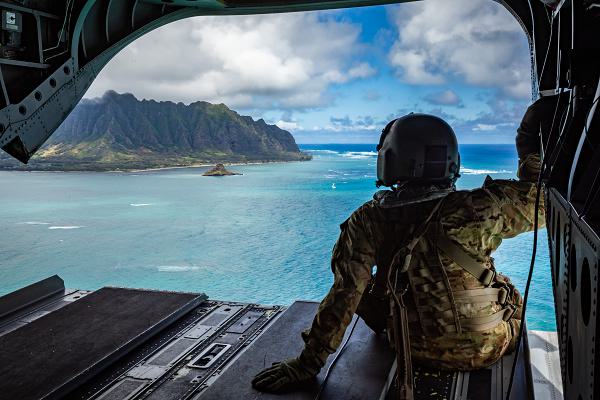
Everyone who has ever served in the armed forces remembers the shock, both physically and psychologically, experienced in the first days of Basic Training. In this photo by Sergeant Lianne Hirano, Sergeant Shelby Lewis, a flight engineer assigned to Company B, 2nd Battalion, 211th Aviation Regiment, 103rd Troop Command, Hawaii Army National Guard, conducts flight operations as part of the Recruit Sustainment Program. In an effort to lessen the “shock & awe” of Basic for new recruits, this multi-phase program gives new recruits vital information and physical training to prepare them for Basic Training.
The Hawaii National Guard operates a Regional Training Institute at Waimanalo, Hawaii, that primarily focuses on ensuring these new recruits are “mentally prepared, administratively correct, and physically ready” to successfully complete basic training. The training begins with issuance of the Army’s “Blue Book” ; a comprehensive guide to help get recruits comfortable with the military terminology and the protocols expected of them. The book also includes information on the Army’s core values, rank structure, courtesies, and customs. Recruits are taught military time, the phonetic alphabet, and the “Soldiers Creed”. The goal is to acquaint recruits with the knowledge they will need to navigate life in the military before they ship off to basic training.
It is a troubling fact the up to 70 percent of today’s potential recruits are ineligible to serve due to a lack of physical conditioning according to the Department of Defense. The National Guard is tackling this problem by giving recruits an Army Physical Fitness Test and then a tailored work-out plan over the following months to prepare them for the rigors of combat training. Newly minted Guardsmen quickly learn what level of fitness is required to survive.
Finally, the Guard offers recruits “Stripes for Skills” that allows especially knowledgeable candidates a chance to receive promotions based on demonstrated skills they already have. The Guard hopes these measures result in higher success rates for basic trainees by lessening the “shock and awe” as they begin their military career.


